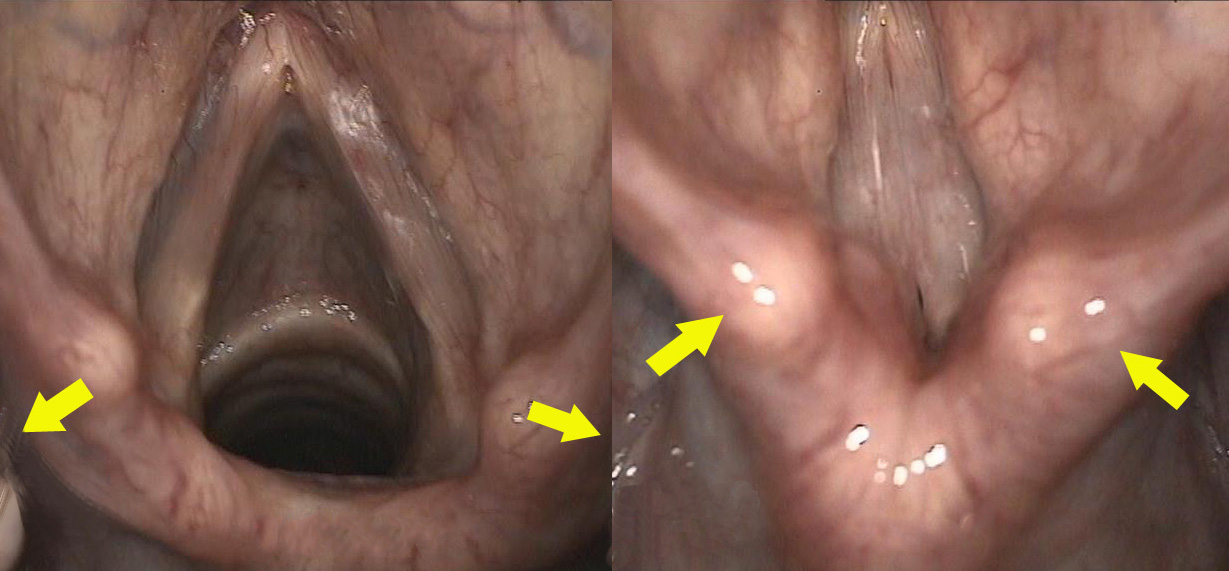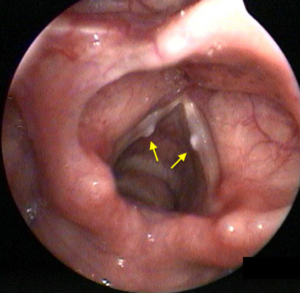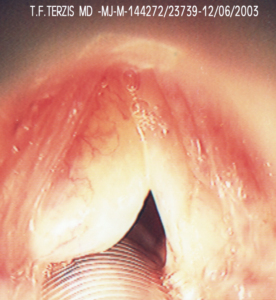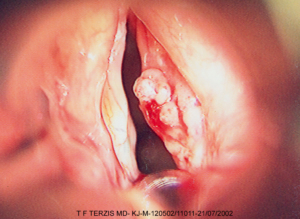Diseases of the Vocal Cords

The vocal cords are thin muscles inside the voice box, which are covered by mobile mucosa. Both the muscle and the mucosa vibrate by the exhaled air and produce a sound, which will then be tranformed to voice, in the pharynx and mouth.
Diseases of the vocal cords may be either benign or malignant. Common benign diseases of the vocal cords are:
- Vocal nodules (singers’ nodes)
- Polyps
- Polypoidal swelling (Reinke’s oedema)

Vocal Nodules or Singers’ Nodes, a common problem of the singers and other voice professionals, are a functional disease, caused by improper or excess use of the voice.
At the beginning of their formation, they are minute soft mucosal swellings, at the point of maximum vibration of the vocal cords, between the anterior and middle third of the cord’s length. They always come in pairs, on both vocal cords. With time, they may harden and become fibrous. Soft mucosal nodules usually subside with proper use of voice, while hard fibrous nodules may need surgical excision. In most cases, speech therapy is necessary.

Laryngeal polyp is a soft mucosal swelling, often at the frre edge of one vocal cord. The effect on the quality of voice depends upon its size and location. Treatment is surgical excision.

Polypoid degeneration of the vocal cords is generalised swelling of the whole length of the cords, causing significant hoarseness and impairement of the quality of voice. Treatment is surgical excision or debulking of the cord by aspiration of the submucous oedema. If excision is decided, the anterior end of one cord is preserved, to prevent anterior adhesion.

Leukoplakia
Leukoplakia of the larynx is a change in the microscopic structure of the vocal cord, which hardens and is covered by a white plate. If it is located on the free edge of the cord, it causes hoarseness. Leukoplakia is considered pre-malignant, as it can co-exist with or progress to carcinoma.Therefore, it is treated with care. It requires surgical excision and close follow-up.

Cancer of the larynx
Cancer of the larynx may have various forms and histological types. If it is located at the free adge of the cord, it is revealed early and the prognosis is very good. Laser surgery offers excellent results, even in large tumours. During the last few years, the progress of surgical techniques and the evolution of radiotherapy have reduced the need for big operations, which were the rule in the past. As in all types of cancers, early diagnosis plays a very significant role in the efficient management and it contributes in post-treatment good quality of life.
Prevention
Proper use of voice, avoidance of smoking and alcohol abuse and control of gastro-oesophageal reflux, when indicated, are the most important preventing measures for all laryngeal pathology.
These instructions apply for everybody, but especially for voice professionals. Singers and actors must realize that their larynx is their work tool, and therefore they have to treat it with respect. In every abnormality of the voice or if hoarseness persists, they must consult with a specialist as soon as possible, to have their larynx examined and their voice assessed.
The same imstructions apply for the prevention of the malignant laryngeal disease, where early diagnosis saves lives. Every change in the quality of the voice lasting for more than 10 days, must be examined by endoscopy.
This website aims at providing simplified scientific information and not medical advice on specific conditions or individual cases. In this respect, it cannot replace the consultation and documented opinion of a specialist physician.